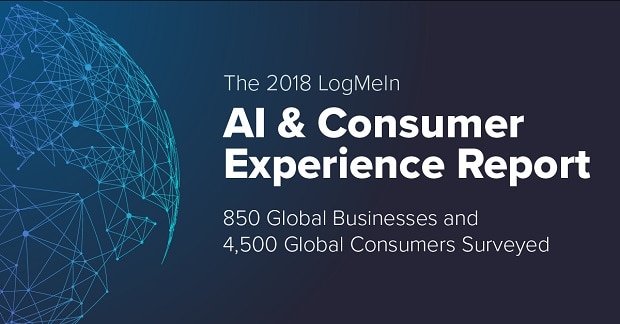
The LogMeIn’s 2018 AI Customer Experience Study also shows that average time to resolution is nearly three times higher than customers find acceptable.
The study surveyed over 5,000 respondents made up of both business leaders and consumers around the globe.
Key findings include:
- 68 per cent of businesses admitted their agents struggle with the volume of customer enquiries
- Less than half (49 per cent) of customer enquiries are resolved during the first interaction
- 65 per cent of businesses would not replace customer service agents with bots: If they could reduce the number of enquiries, they would re-train staff to handle different or additional tasks
- 74 per cent of consumers see the benefits of interacting with chatbots but only 32 per cent believe that leveraging a chatbot in some capacity – either alone or with the assistance of a human agent, provides the best results.
- However, over half (54 per cent) of consumers and 76 per cent of businesses believe artificial intelligence is changing customer experience for the better
The research revealed that over one-third of consumers were not impressed with their customer journey citing an average or poor experience with 83 per cent of consumers citing that they had at least one issue while interacting with a brand.
Businesses, on the other hand, are reporting much different numbers. Eighty percent of businesses believe their customers would give them a favourable review despite also reporting that less than half of customer queries are resolved during the first interaction. This disconnect shows that companies are setting the bar for “good” service too low which could have significant business impact as customer experience becomes even more vital in the buying decision of consumers.
In fact, the research found that while retail and travel and hospitality industries lead the pack when it comes to good customer experience, only 58 per cent of consumers rate their experience highly in each of these sectors, while telecoms ranked worst with only 41 per cent of consumers giving a favourable rating. This contradiction between the customer and business perception is a pervasive issue plaguing companies of all sizes and industries.
Consumers Rely on Classic Channels Despite Providing Slower Resolution
Both business and consumer respondents agree that telephone and email are among the most common channels used to conduct business, however they also tend to produce the slowest time to resolution. Consumers reported that the average time to resolution was 11 hours – which is nearly 3 times higher than the wait time they cited as being acceptable. And these times increase for those using telephone interactions (7 hours) and email (18 hours). In addition, these channels aren’t providing effective results with businesses reporting that only 49 per cent of problems are solved on the first interaction. These wait times and issues with first contact resolution are likely due to the fact that 68 per cent of businesses believe their agents struggle with the volume of customer requests.

Businesses Are Investing in Customer Experience
Feeling that traditional customer engagement solutions aren’t meeting expectations, 61 per cent of business respondents said they will allocate more budget to new solutions specifically designed for customer engagement over the next 12 months. In addition, 35 per cent of businesses have already invested in emerging technologies like AI with another 53 per cent planning to invest. Companies anticipate these investments will increase customer satisfaction, resolve customer inquiries more quickly, be able to provide a more personalised experience and increase agent satisfaction levels. In addition, over 70 per cent of consumers want brands to leverage technology to reduce time to resolution.
Chatbots: A Realistic View
Today, only 32 per cent of consumers believe they get the best results when interacting with a brand when an AI-powered chatbot is involved in some capacity – either as a self-service tool or to assist a human agent. And while there is a portion of consumers who are skeptical about chatbots, a majority (74 per cent) see the benefits for customer service.
Businesses agree that chatbots can help deliver the faster resolutions for customers while also helping agents be more productive and effective. To date, customer service agents use an average of 3 different systems to service a customer and spend over half their time understanding basic facts like customer profile information and the nature of the inquiry. Operating behind the scenes chatbots can gather this information in real-time – informing the agent of who they are talking to, their history with the brand, the potential problem the customer is having, and how to solve it. Having this information at the outset leaves agents more time to spend on resolving the issue. And answering the hot button question of whether chatbots will replace human jobs, the answer was no. In fact, 65 per cent of organizations reported that if chatbots could reduce inquiries into call centers, they would train agents to handle different or additional tasks.
“What we learned from doing this study is that despite hesitations around using AI, both consumers and businesses do think it’s changing customer service for the better,” said Ryan Lester, Director of Customer Engagement Technologies at LogMeIn. “While customers, for the most part, have come to accept that their interactions with brands will be involved and time consuming, their expectations are increasing as new technologies become more commonplace. Companies have a unique opportunity to leverage these new advancements — like chatbots — to provide a leg-up on the competition and set the bar for all others in their industry and beyond.”
